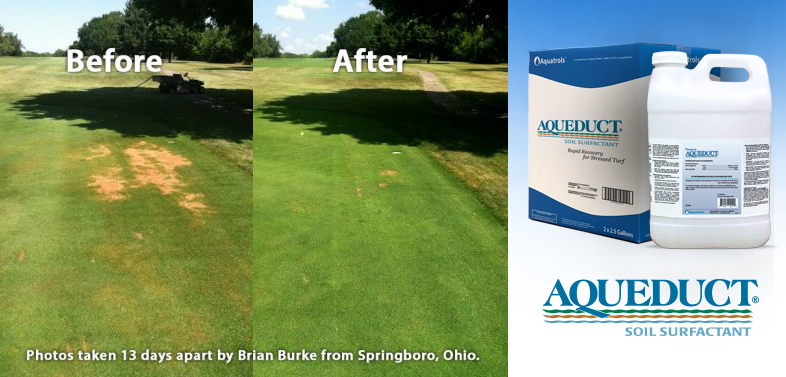Implementation of soil surfactants in the golf season is a great way to manage water movement which maintains robust turf health at the top level of the rootzone. What happens when water, either irrigated or from rainfall, can’t get through that top layer? This is most commonly referred to as water repellency.
Causes of Water Repellency
Hydrophobicity in the soil profile is a wax-like coating that accumulates on soil particles, and is a byproduct of organic matter decomposition. It can also be caused by plant root exudates and fungal hyphae, and is exacerbated by wet/dry cycles.
Water repellency causes water movement problems in two different ways: 1) at the surface, it impedes water’s movement into the soil, sitting on top and evaporating or running off, and 2) below the surface it can also disrupt water’s ability to move freely through the rootzone. This results in uneven distribution of water (and anything it carries with it) and can also lead to preferential flow patterns where the water takes the “easy way” through the soil, straight down past the roots.
Depending on the location, type of repellency (localized or generalized) and the severity of the problem, there are different types of surfactant formulations to choose from. Your distributor and/or an Aquatrols representative can help you choose the right one for your situation.
Signs and Consequences
On the golf course, this translates to localized dry spots, irregular shaped patches suffering from drought stress, or puddles of surface water (aside from those resulting from saturated soils due to heavy rains or faulty irrigation). In and around sloped areas, hydrophobic soil could cause runoff of both water and nutrients to pool in low areas.
If water repellency is preventing water from moving effectively through your soils, it’s preventing water-soluble nutrients and other applied materials from moving effectively too. This not only prevents your turf from uniformly getting what it needs, but also increases the potential for loss of expensive inputs and can have a negative environmental impact.
Combatting Water-Repellency from the Top Down
If signs of water-repellency emerge, surfactants can help break through the surface and deliver water and nutrients throughout the entire rootzone. In a 2013 survey funded by the USGA, more than 90 percent of superintendents reported the use of surfactants in their agronomic programs. Applying a wetting agent reduces runoff and becomes cost effective as you save water, fertilizer, and other resources. Throughout the years, research has shown that surfactants improve the efficiency of water use on sand-based greens.
Our broad-use surfactant, Dispatch, allows water to penetrate the soil surface quickly and filter down into the soil profile, reducing loss to runoff and evaporation. Revolution, specifically formulated for use on highly managed turf areas such as greens and tees, can move moisture more uniformly throughout the rootzone.
For highly problematic areas, Aqueduct and Aqueduct Flex (liquid and granular, respectively) are specifically designed to rapidly treat localized dry spots that begin on the surface. In as little as three days, Aqueduct and Aqueduct Flex help reverse the effects of water repellency to prevent turf wilting and promote a quick recovery.
Staying Out Ahead of Water Repellency
In addition to adding soil surfactants to your turf maintenance program (both proactively and reactively), keep track of where problem areas occur year after year. It is to note that along with water repellency issues, stubbornly reoccurring dry spots can also be an indicator of poor irrigation coverage or a larger problem beneath the soil.



Comments are closed.